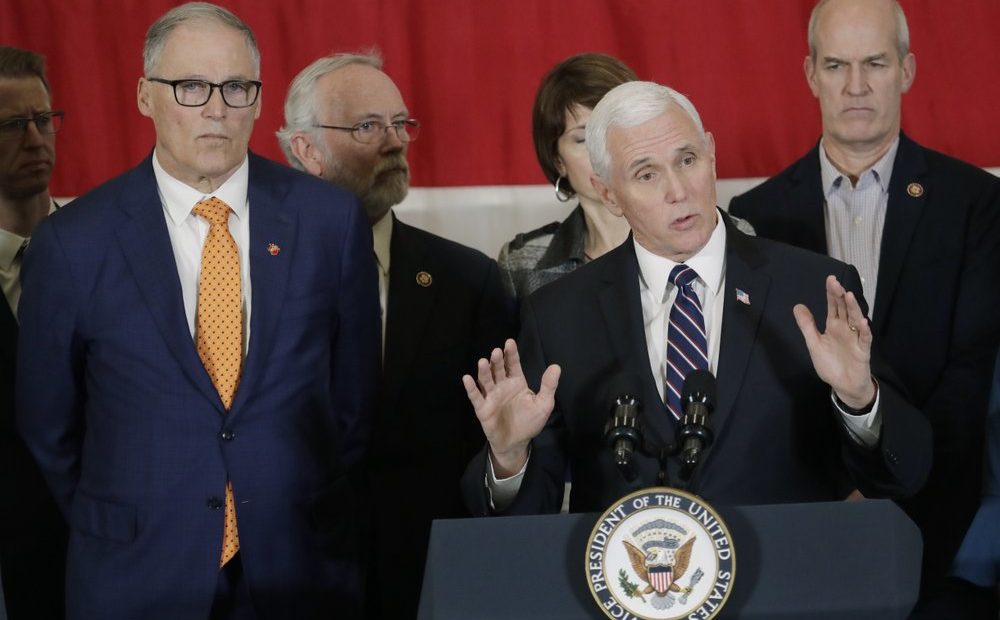
Vice President Pence Visits Washington State As Coronavirus Outbreak Grows
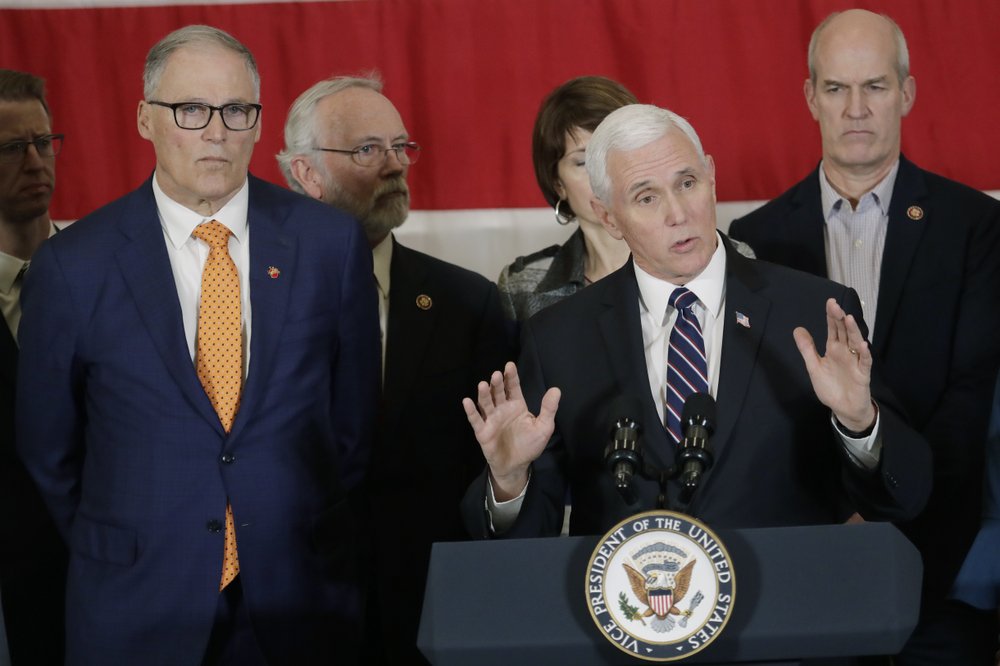
READ ON
As the death toll climbs and the number of confirmed COVID-19 cases in Washington tops 70, Vice President Mike Pence traveled to the state Thursday to tour the Military Department’s Emergency Operations Center, meet with Gov. Jay Inslee and other elected leaders and announce the arrival of a shipment of supplies for healthcare workers from the Strategic National Stockpile in Atlanta.
“As we stand here today, our hearts grieve the loss of 12 Americans, particularly to those families here in Washington state,” Pence said at an early evening news conference at Camp Murray, the state’s National Guard headquarters. “Please know that you have the condolences of every American.”
Pence is leading the White House’s task force on the coronavirus response. Washington has emerged as the epicenter of the outbreak in the U.S. with 11 deaths so far, mostly related to a single nursing home in Kirkland.
At the news conference, Pence was flanked by Inslee, members of the state’s congressional delegation, the director of the Centers for Disease Control (CDC) and the administrator for the Centers for Medicare and Medicaid Services. The vice president spoke in front of a giant American flag and displays of medical supplies, including gloves, hand sanitizer and masks. On Thursday, the state received an initial shipment of protective medical equipment from the nation’s strategic stockpile.
But according to the Washington Department of Health (DOH), the shipment represented only about half of the 233,280 N95 respirators, 200,000 surgical procedure masks, 60,000 disposal gowns and 5,000 protective eye shields the state has requested. A DOH spokesperson said the state expects to get the second half of the request, but it’s not clear when. On Thursday, The Washington Post reported that Washington’s half-filled request was evidence of a shortage of vital medical equipment needed to respond to the growing crisis. The supplies will be reserved for frontline health care workers engaged in the coronavirus response.
Prior to Pence’s arrival in Washington, U.S. Sen. Patty Murray released a sternly worded four-page letter demanding answers to a number of questions about the Trump administration’s handling of the coronavirus response. Of particular concern to Murray were delays in the availability of diagnostic tests.
“I am extremely frustrated by how the Trump Administration has handled the deployment of such tests, including how it has communicated to Congress and the public about when, where, and to whom tests will be available,” Murray wrote in her letter to Pence. “In the midst of this public health emergency, the Trump Administration must do better.”
Since the first case of coronavirus was confirmed in the U.S. – a man from Washington state – on January 20, there have been delays in making diagnostic tests available, limited lab capacity to confirm COVID-19 and restrictive guidelines on who could be tested. From late January until last week, according to Murray, only 500 people in the U.S. were tested for coronavirus. Some public health experts said that limited testing likely resulted in the undetected spread of coronavirus in Washington, and elsewhere, over the past several weeks.
In recent days, the state’s public health lab in Shoreline and a lab at the University of Washington have been certified to analyze coronavirus test swabs. Previously, those swabs had to be sent to CDC in Atlanta. The capacity to test for the new coronavirus locally is rapidly increasing, and more in-state testing capacity is expected to come on line through private diagnostic labs in the coming weeks.
Meantime, the criterion for who can be tested is being relaxed. Late on Wednesday, the CDC announced it expanded its guidelines for coronavirus testing to encompass a “a wider group of symptomatic patients.”
However, the updated guidance is taking a little while to filter down from the CDC through state health authorities to front line health care providers. Inslee said he expects expanded testing may relieve the anxieties of people who have a fever and a cough, but aren’t so sick that they need to be in the hospital.
It remains the case that individuals can’t self-refer to get tested for the coronavirus. A doctor must judge screening to be prudent and justifiable, after ruling out more common afflictions such as the seasonal flu.
“I certainly understand the desire of people who are currently sick to want to be tested for COVID-19 infection,” said State Health Officer Dr. Kathy Lofy during a media briefing in Olympia Thursday. “We currently do not have medications to treat COVID-19 infection. So, whether or not you test positive or negative, your provider’s medical management will be the same.”
In her letter, Murray expressed skepticism about the federal government’s claims that it’s rapidly scaling up the availability of testing. On Wednesday at the White House, Pence announced that more than 2,500 testing kits were being deployed across the country this week which would allow for 1.5 million tests to be conducted on people suspected to have COVID-19.
Murray, though, questioned that timeline, citing projections from the Association of Public Health Laboratories – representing commercial labs — that said they are “a couple of weeks away from being able to deploy a million tests through this process.”
“It is difficult to tell my state and people across the country what to expect with such conflicting estimates,” Murray wrote to Pence.
Before arriving in Washington on Thursday, Pence made a stop in Minnesota where he toured 3M, a major manufacturer of respiratory masks. While there, Pence acknowledged that “We don’t have enough tests today to meet what we anticipate will be the demand going forward.”
But in remarks in Washington state, Pence pledged that more testing capacity was coming online rapidly and predicted that 1.2 million Americans would soon have access to testing with another four million tests becoming available later this month.
Among the questions Murray wants Pence to answer by March 19 are: how many test kits will be deployed and how many patients will be able to receive testing.
Prior to Pence’s visit to Washington, tensions were also on display between the vice president and Inslee, a Democrat, who was previously a 2020 candidate for president.
Last Thursday, prior to the first death in the U.S. from coronavirus, Pence called Inslee to thank him for Washington’s response to the outbreak. Following that call, Inslee tweeted about the vice president from his personal Twitter account: “I told him our work would be more successful if the Trump administration stuck to the science and told the truth.”
In response, Washington State Republican Party Chair Caleb Heimlich took to Twitter to accuse Inslee of “playing politics and posturing as a tough guy.”
However, on Tuesday of this week, from his official Twitter account, Inslee struck a more conciliatory tone with the Trump administration. He said he had talked with Pence and CDC Director Robert Redfield and asked them to remove restrictions on access to testing.
“They have announced changes consistent with what I had asked for,” Inslee tweeted. “I appreciate the responsiveness to state requests on COVID-19.”
In remarks at the news conference, Inslee thanked the vice president and called it a “good partnership” while also acknowledging his history of strong disagreements with President Trump.
“We’re not going to allow some disagreements with any one individual in that government to dissuade us from doing really important work that are life and death issues for the people of the state of Washington,” Inslee said
Related Stories:
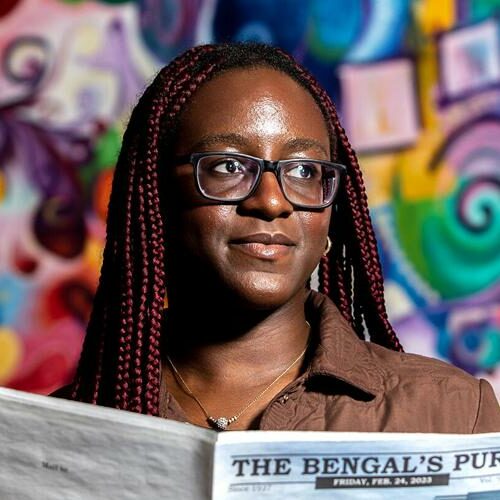
What we learned from COVID: Oluwaseyi Arogudade
When COVID-19 reached the Inland Northwest, few people could have predicted its profound changes. NWPB’s Rachel Sun interviews local residents about how the pandemic changed their mental health, lives and perspective. This is the first in a four-part mini series.
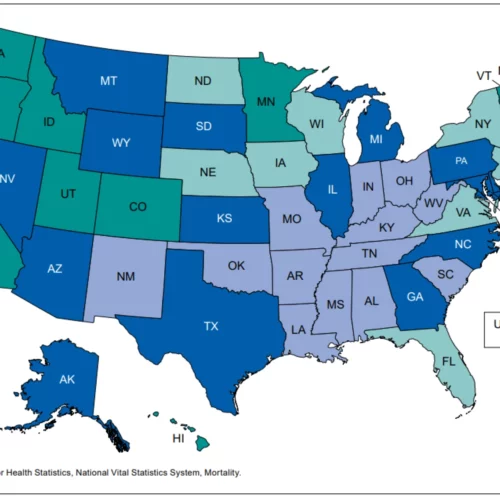
Washington And Oregon Among States With Longest Life Expectancy, But Pandemic Hurt
Washington and Oregon rank in the top ten states for the longest life expectancy, according to new numbers from the Centers for Disease Control and Prevention. The high rankings come with the caveat that the pandemic has thrown lengthening human lifespans into reverse across the U.S.
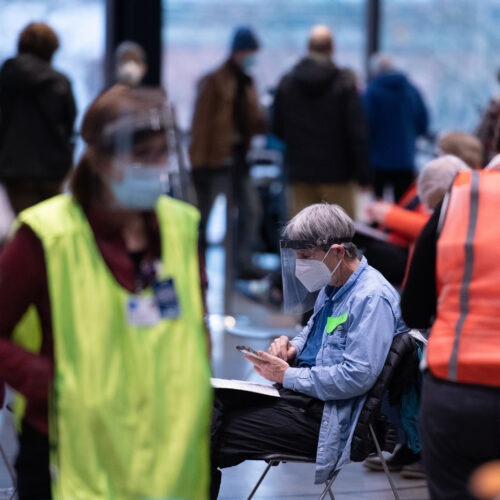
Experts Weigh In On 2nd Booster For 50+
The FDA has approved a 2nd COVID booster shot for people 50 and older CREDIT: Grant Hindsley/AFP via Getty Images Listen NWPB’s Rachel Sun talks to experts about the FDA















